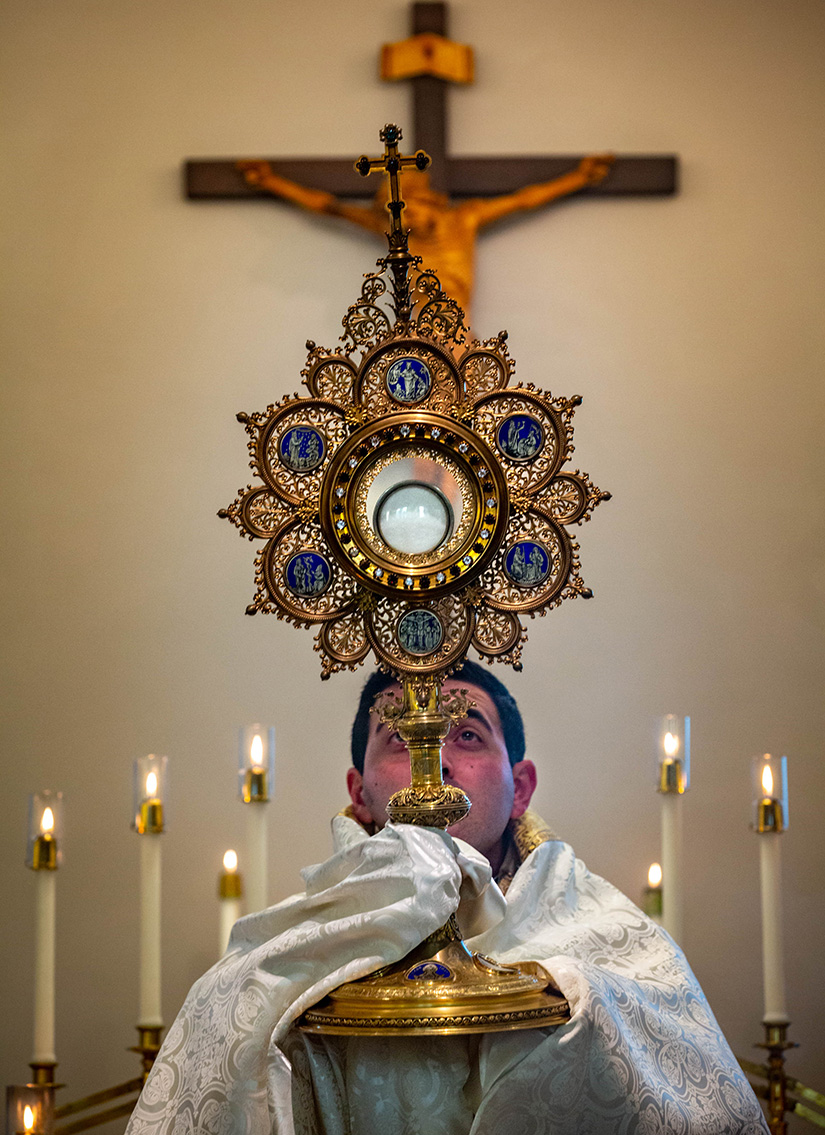 Father Fadi Auro, assistant professor of philosophy and formation advisor at Kenrick-Glennon Seminary, elevated the monstrance during the seminary’s Forty Hours devotion Feb. 16.Photo Credit: Lisa JohnstonMost of us know that the number 40 is biblically significant. Examples are plentiful: During the time of Noah, it rained for 40 days and nights. The Israelites wandered the desert for 40 years. Christ fasted and prayed for 40 days before the start of his public ministry. And of course, there’s the 40-hour period between His burial and the Resurrection.
Father Fadi Auro, assistant professor of philosophy and formation advisor at Kenrick-Glennon Seminary, elevated the monstrance during the seminary’s Forty Hours devotion Feb. 16.Photo Credit: Lisa JohnstonMost of us know that the number 40 is biblically significant. Examples are plentiful: During the time of Noah, it rained for 40 days and nights. The Israelites wandered the desert for 40 years. Christ fasted and prayed for 40 days before the start of his public ministry. And of course, there’s the 40-hour period between His burial and the Resurrection.
Forty Hours devotion is — quite literally — 40 hours of continuous prayer before the Blessed Sacrament. A centuries-old practice, it is an affirmation in our belief as Catholics in the Real Presence of the Lord in the Eucharist. “Lumen Gentium,” one of the principal documents of the Second Vatican Council, notes that the Eucharist is “the source and summit of the Christian Life” (“Lumen Gentium,” No. 11).
One of St. John Paul II legacies was the promotion of eucharistic adoration. “The worship of the Eucharist outside of the Mass is of inestimable value for the life of the Church,” he wrote in the 2003 encyclical, “Ecclesia de Eucharistia.”
Forty Hours devotion fell out of practice in the decades following the Second Vatican Council, but some parts of the Church have seen a renewed interest. In the Archdiocese of St. Louis, Kenrick-Glennon Seminary regularly hosts a 40 Hours devotion. Another example is St. Francis of Assisi Parish in Oakville recently offered it for the first time this Lent, in late March.
Father Anthony Yates was introduced to the devotion as a Kenrick-Glennon seminarian. “It was amazing to see the guys going to the chapel at 2 in the morning,” said the pastor of St. Francis of Assisi. “Our parish is always trying to bring people closer to the Mass and the Eucharist. We saw this as a way to expose more people to (adoration) in a bigger way.”
The devotion generally begins with a solemn Mass and procession with the eucharist, followed by exposition at the altar. During the next 40 hours, people gather for personal or public prayer in adoration. If a church offers regular daily Mass during the 40-hour period, the Eucharist is reposed in the tabernacle at that time. At the end of adoration, a Mass of Reposition might be celebrated, following with another procession, and ending with Benediction and final reposition of the Eucharist.
Spending time in adoration, Father Yates said, helps us to become closer to Jesus and deepens our relationship with Him. Regarding the Real Presence in the Eucharist, “faith will tell us Christ is present when the human sense fail,” Father Yates said. “It’s going to be that faith of our heart that draws us closer to Him as a person. And the only way you can become closer is to spend time with Him.”